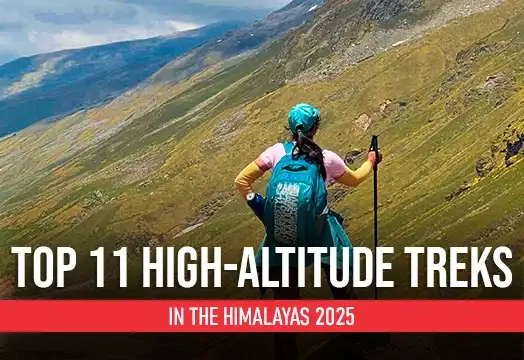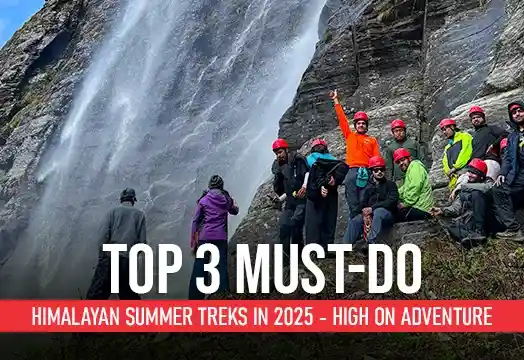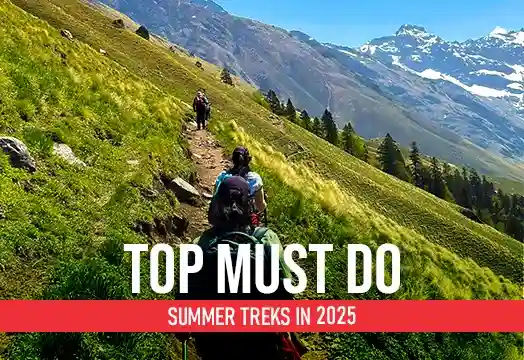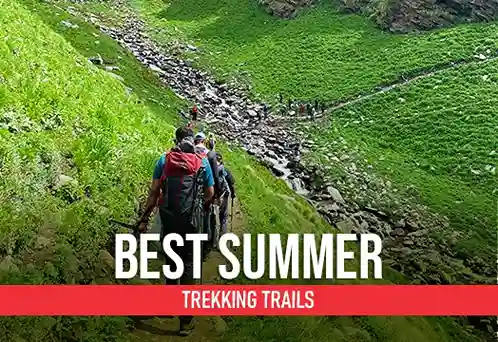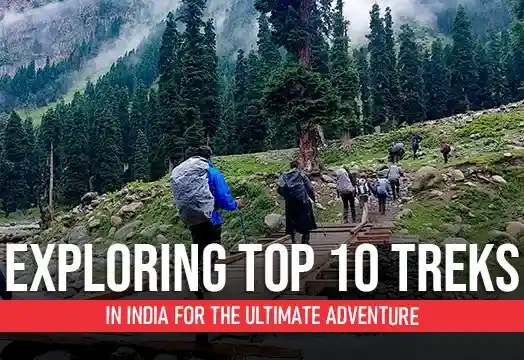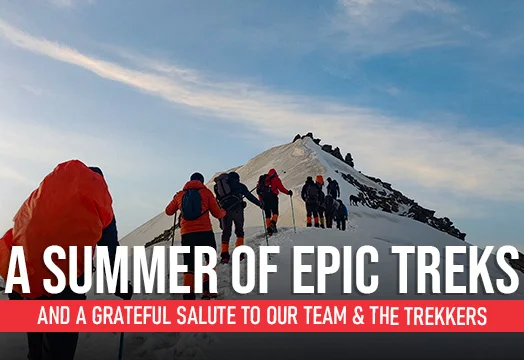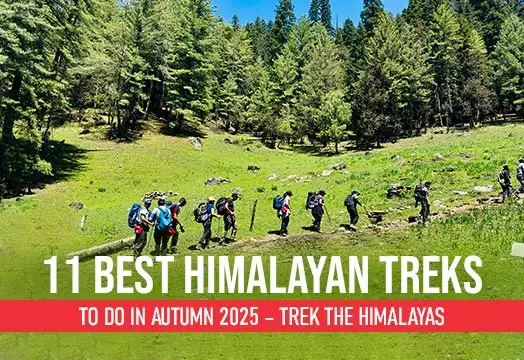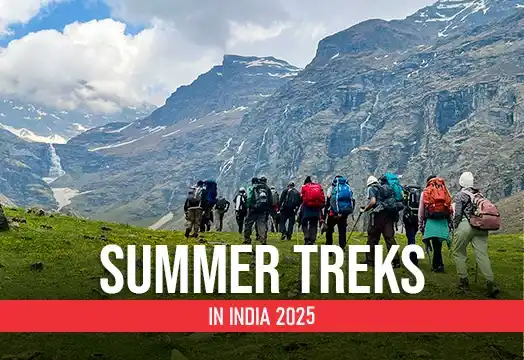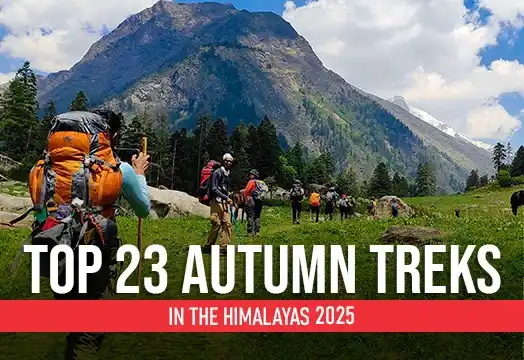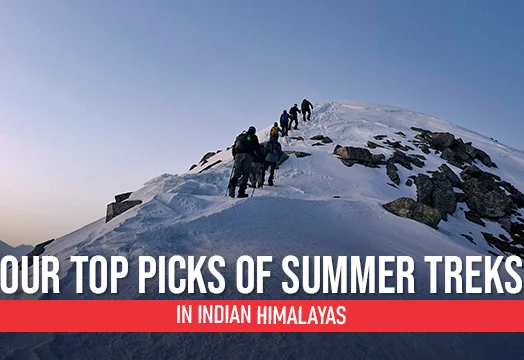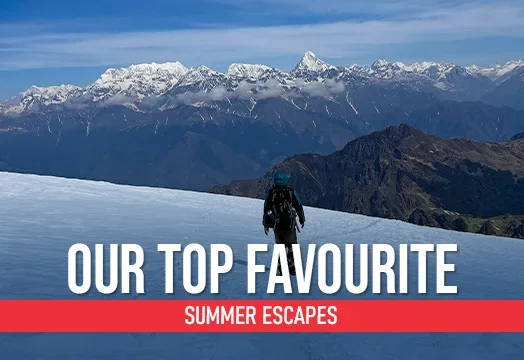Rupin Pass Trek

Region
Himachal Pradesh | India

Duration
7 Days

Max Altitude
15350 Ft.

Trekking Km
41 KM

Grade
Moderate to Difficult
Get in Touch with Our Trek Expert
91 90456 54448 info@trekthehimalayas.comMonday - Saturday: 10 AM to 06 PM (GMT +5:30)
16500 /Person
- September-2025
- October-2025
- May-2026
- June-2026
- 5% GST will be applicable on Trek Cost and Add-ons
- Services Bawta to Sangla.
- Meeting Point( Pickup/ Drop Point ): Old Bus Stand, Shimla
- Reporting Time: 5:30 am
- Drop Time: 11:00 pm to 1:00 am (Timings are subject to change based on weather and road conditions).
- Please reach Shimla a day before to avoid any delays.
Add-ons
Insurance 245
- Insurance is mandatory.
- It is available for Indian citizens only.
- Non-Indians have to take insurance on their own.
- If you already have the high altitude trekking insurance, email for a refund after booking.
- The cancellation policy will be implemented in accordance with the trek cancellation policy.
- For more details about insuranceclick here
Transport 4000
- Transportation from Shimla to Bawta & Sangla to Shimla return is optional.
- Choose add-ons during booking. If missed, log in and add them later.
- Book transportation at least 10 days before the trek.
- Cancellation 4 or more days before the start of the trip results in a 100% cash refund.
- Cancellation less than 4 days from the start of the trip results in a 50% cash refund.
- Cancellations made on the trip date are not eligible for a refund.
Offload 4800
- Backpack offload is optional.
- Choose add-ons during booking. If missed, log in and add them later.
- Book offload at least 10 days before the trek.
- For offline bookings at the base camp, a convenience fee of Rs. 5800 applies.
- Cancellations made before the trip date will receive a full refund.
Single Occupancy Tent 3000
- Single Occupancy Tent is optional.
- Choose add-ons during booking. If missed, log in and add them later.
- Book Single Occupancy Tent at least 10 days before the trek.
- Cancellations made before the trip date will receive a full refund.
Get in Touch with Our Trek Expert
91 90456 54448info@trekthehimalayas.com
Monday - Saturday: 10 AM to 06 PM (GMT +5:30)
Overview
Trek Name: Rupin Pass Trek
Days: 7
Adventure Type: Trekking
Base Camp: Shimla
Season:Summer |
Month:May | June | September | October |
Country: India
Altitude: 15350 Ft.
Grade: Moderate to Difficult
Rail Head: Kalka
Stay: Camping (Twin sharing) & Home Stay (Dormitory) (Separate for male & Female)
Food: Meals while on trek & at Hotel/Guest house (Veg & Eggs)
Location: Himachal Pradesh
Distance: 41 Km.
Trail Type: Cross over trail | Start in one valley, traverse the pass, and ends in another valley.
AirPort: Jubbarhatti Airport, which is 22 km away from Shimla
Highlights:
- 5% GST will be applicable on Trek Cost and Add-ons
- Services Bawta to Sangla.
- Meeting Point( Pickup/ Drop Point ): Old Bus Stand, Shimla
- Reporting Time: 5:30 am
- Drop Time: 11:00 pm to 1:00 am (Timings are subject to change based on weather and road conditions).
- Please reach Shimla a day before to avoid any delays.

Why is Rupin Pass a Must-Do trek ?
- Rupin Pass Trek is one of the most scenic treks in Himachal, it takes you through diverse landscapes, changing from lush green valleys to snow-covered terrains.
- Every turn during this trek will surprise you with some amazing sceneries, including cascading waterfalls, snow bridges, and panoramic mountain vistas.
- Crossing the thrilling Rupin Pass is a memorable adventure in itself.
- The waterfalls during this trek will leave you in awe with their beauty, especially the three stage Rupin waterfall, which looks magical.
- You get a unique experience of trekking besides a waterfall, with the gushing water flowing besides you.
- Witness the Jakha village, also known as the hanging village, because of its appealing position on the mountain side.
- The trek passes through local villages, providing you an opportunity to engage with the local culture and witness the Kathkuni architecture of the houses.
- The final push towards the pass involves walking on the snow and climbing over ridges, giving you a thrilling trekking experience.
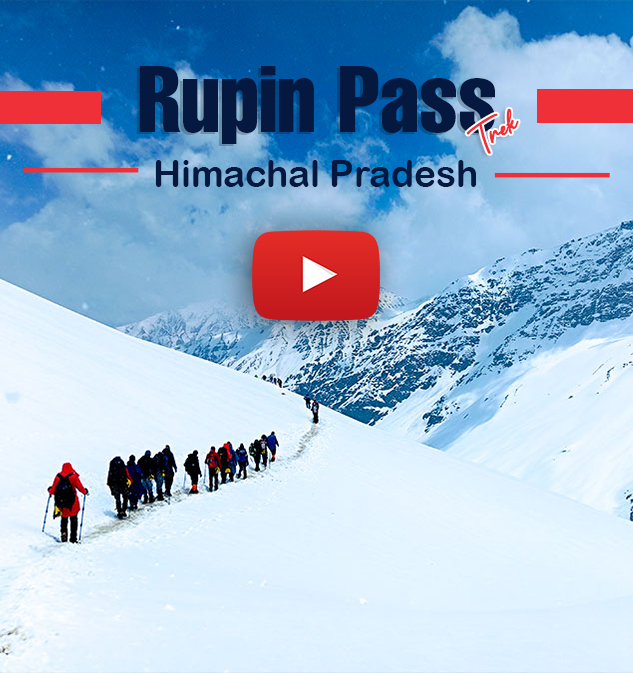
Who Can Participate
- Age Requirement:
- Minimum 14 years
- First-timers are welcome, though prior trekking experience is preferred. Good fitness is a must.
- Fitness Criteria:
- If the trekker wants to carry a backpack then he/she should be able to carry a 10-12 kg backpack. If opt Off-load option then the trekker should be able to carry 3-5 kg backpack.
- If a trekker's BMI is more or less than the normal range (18-27), please consult our Trek Coordinator before booking.
Go trekking as many times as you like!!!
At Trek The Himalayas, we understand that things don’t always go as planned. If you couldn’t complete your trek or just want to experience it once more, we’re giving you a wonderful opportunity – the chance to do the trek again without having to pay the trek fee again.
Pay a one-time fee to select your favourite trek, and you can repeat it as many times as you want within 5 years.
Terms and Conditions:
- The offer is valid for 5 years from the trek departure date.
- Participants are not required to pay the trek cost again, but they will need to cover transportation, insurance, and trek permit costs.
- This offer is non-transferable and is only applicable to TTH's limited fixed departures.
- The offer does not apply if the participant has received a refund, a voucher, or a transfer to another trek that has been used previously.
- The offer will be activated once the participant reaches the trek base camp.
- This is not an offer linked to any purchased package; rather, it is an initiative extended by TTH out of goodwill, without any cost to the trekkers.
- Trek The Himalayas reserves the right to cancel this offer at any time, in case of:
- Disobeying the safety regulations, trekking rules, or the code of conduct
- Black listing due to bad behavior, payment issues, or providing inaccurate information
- Anything that would damage the brand or reputation of TTH
- In order to rebook, just fill in our booking form online or call our team.
Rupin Pass Trek Itinerary
Arrival In Bawta
- Altitude Bawta: 2,350 m/ 7,700 ft.
- Drive Distance: 195 km | 8 - 9 hr.
- Accommodation: Homestay
Your Rupin Pass Trek begins in Bawta, a peaceful Himalayan village located in the mountains. The journey to Bawta is a long but pleasing drive from Shimla, with views of the valleys and rivers along the way. If you have opted for transportation with us, our team will pick you up from the Shimla Bus Stand, and together, we’ll head towards this charming base camp.
Leaving Shimla behind, the road takes you through mountain terrain. You’ll pass through Rohru, a small town on the bank of the Pabbar River, which also serves as the last ATM point before the trek. After Rohru, the route splits. One leading to Janglik, the base camp for Buran Ghati Pass Trek, and the other leading to Bawta, your base for Rupin Pass Trek.
Bawta village stands out for its traditional Kath-kuni style wooden houses, crafted from deodar cedar wood. These homes are not only aesthetically beautiful but also exude a rich, woody fragrance, and provide an extremely warm and comforting atmosphere. The thick wooden walls make the interiors cozy and well-insulated, that is perfect for the chilly mountain nights.
At night, you can step outside and look up. The sky over Bawta is dotted with countless twinkling stars. The quiet, starlit surroundings make for a peaceful and magical evening before you settle in for a good night’s rest.
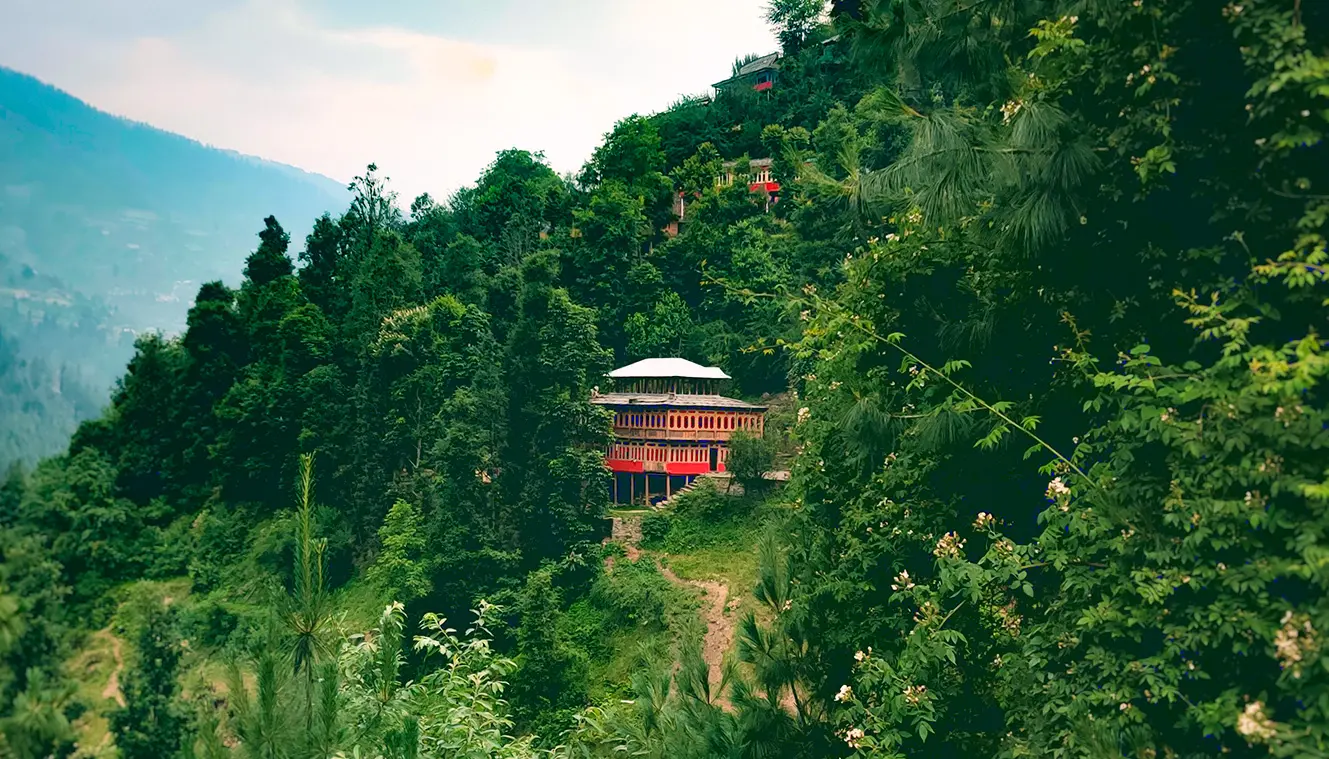
Bawta to Jakha
- Altitude Jakha: 2,750 m/ 9,000 ft.
- Trek Distance: 5 km | 4 hrs.
- Accommodation: Homestay
The trek from Bawta to Jakha starts with a mix of trails, including sections of unpaved roads leading to Jiskun village. As you walk through this quaint Himalayan settlement, you'll notice traditional wooden houses reflecting the architectural charm of the region.
Shortly after Jiskun, one of the most scenic parts of the trek unfolds, where small water streams flow gently along the path. You will cross a wooden bridge built over these streams, a simple yet beautiful structure that perfectly complements the natural charm of the trek.
As you progress further, the trail takes a steep ascent toward Jakha, the highest and last village on this route. Due to its location on a steep slope, Jakha, often called the “Hanging Village,” is a fascinating sight. Settled on a steep slope, it seems to blend seamlessly with the mountains. The houses here are built in a way that they appear to be stacked on top of one another. This unique layout creates a unique sight.
After reaching Jakha, you will settle into a traditional homestay. The cozy interiors provide warmth and comfort after a day’s trek. The evening presents an opportunity for further exploration. You can take an acclimatization walk to Dhara Village, where the temple of Dhara Devta stands. Locals hold deep faith in this deity, and the visit provides a glimpse into the spiritual side of life in these remote mountains.
With a fulfilling day behind you, you can rest in the comfort of your homestay, preparing for the adventure that lies ahead.
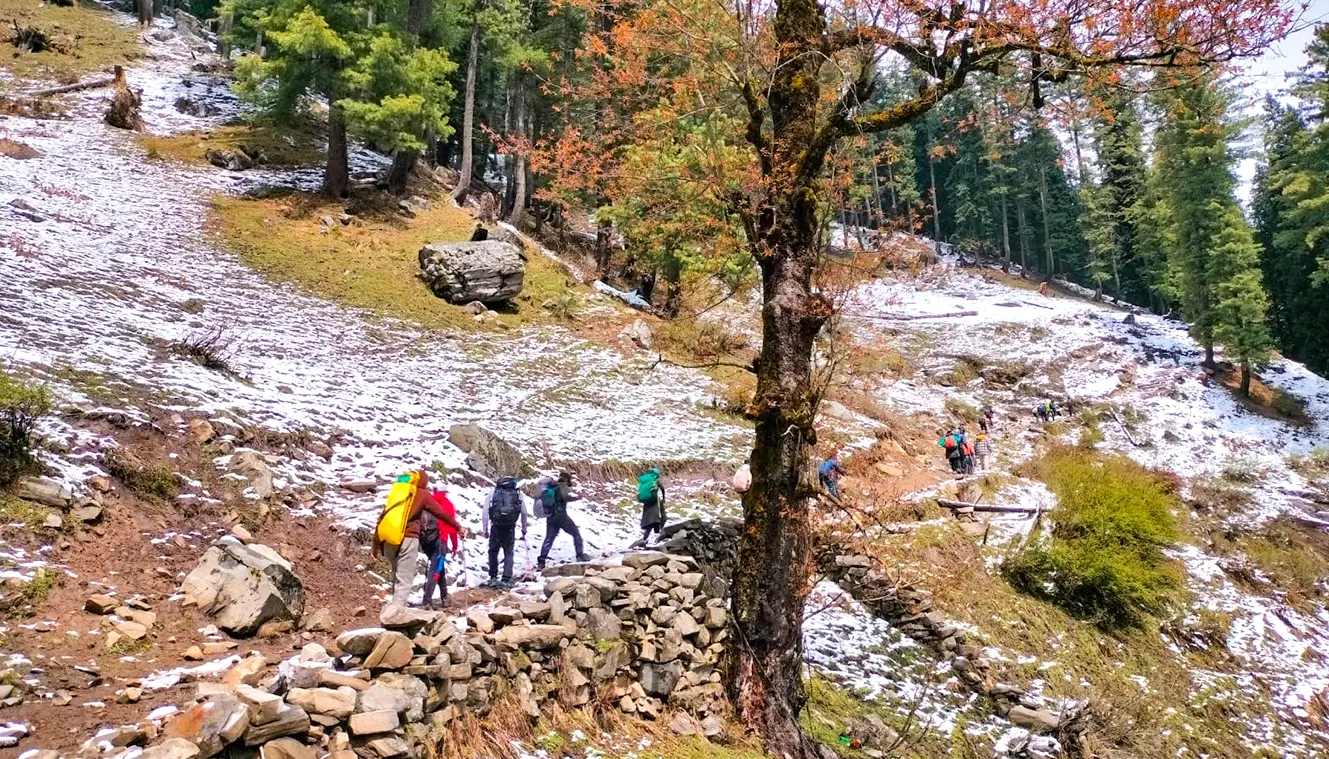
Jakha to Dandreyash Thatch
- Altitude Dandreyash Thatch: 3,550m / 11,700ft.
- Trek Distance: 11 km | 8 hrs.
- Accommodation: Campsite
You start from Jakha, passing through wooden houses, a playground, and farmlands. The first few hundred meters are steep, but soon the trail levels into a gradual ascent. Along the way, you'll come across an old wooden house, weathered by time and nature, standing strong after many years. Its age and charm make it a very unique landmark, and draws trekkers to pause and capture photos. As you continue, you enter the dense forest of cedar and fir trees. The cool shade of the trees makes the walk pleasant, and the fresh mountain air feels refreshing.
After descending through the dense forest, the forest gradually opens up, leading to Udaknal. Here, the landscape changes once again, and you find yourself stepping onto a stunning snow bridge, where you carefully walk across, feeling the crunch of ice beneath your feet. Just beyond this, you’ll come across a wooden bridge built over the Rupin River. Crossing this sturdy yet rustic structure is a memorable moment, with the river rushing below. Once past the bridge, the trail follows alongside the Rupin River, with mesmerizing views of its glistening waters as you continue your journey.
Soon, you’ll see small tea stalls.There are small dhabas here that serve simple, local food, a great place to rest and refuel. Water showers from natural springs appear along the way, adding to the beauty of the route. A little further, you will pass through Buransh Kandi, a small rhododendron forest. If you are trekking in its season, the trees will be covered in bright red flowers. This section is short but adds a lovely contrast to the green surroundings. After some time, the path opens into Saruwas Thatch, a vast meadow with soft grass and beautiful views all around.
From here, you make your way toward Dandreyash Thatch. It’s a bit tiring, but once you reach the campsite, the view makes it all worth it. This is one of the most beautiful camping spots of the trek. The beauty of Dandreyash Thatch takes on different shades. The best part? You get a stunning view of both the Upper and Lower Rupin Waterfalls.
The Upper Rupin Waterfall crashes down from a great height, cutting through the rocky cliffs with force. A mist rises from where it hits the ground, sometimes creating a rainbow in the sunlight. Below, the Lower Rupin Waterfall flows more gently, cascading down in delicate streams that weave through the valley like silver threads. Watching these waterfalls flow down from high cliffs is a sight to remember.
After a long day, you can relax at the campsite, enjoy the peaceful surroundings, and get ready for the next day’s adventure.
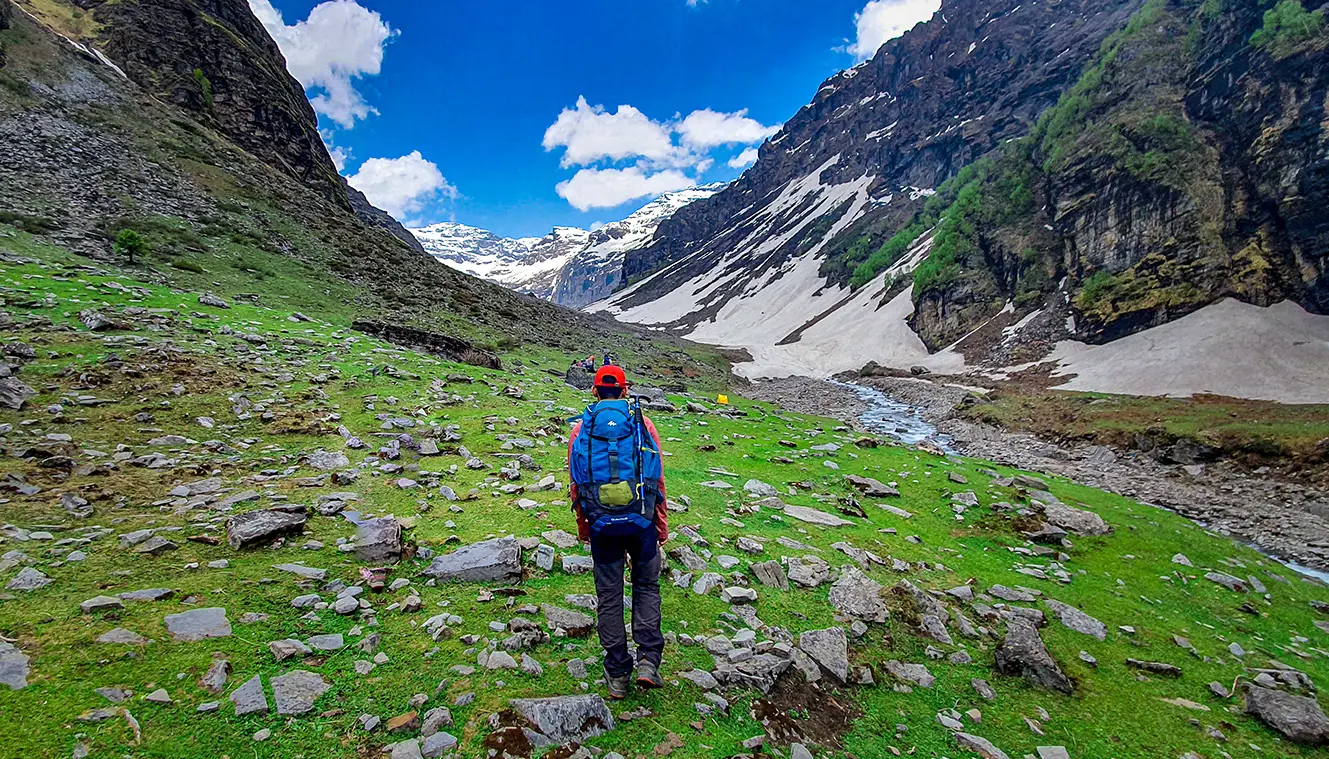
Rest and Acclimatization Day at Dandreyash Thatch
This day is set aside for rest and acclimatization, a vital part of high-altitude trekking. After continuous days of trekking through varying landscapes and gaining significant altitude, your body needs time to adjust to the lower oxygen levels. Proper acclimatization reduces the risk of altitude sickness and helps you feel stronger and more prepared for the challenging sections ahead.
Dandreyash Thatch serves as an ideal location for this purpose. Located in a vast, open meadow, it provides a peaceful retreat surrounded by mountains. The serene environment, fresh mountain air, and gentle warmth of the sun make it a perfect spot to recover and regain energy. Trekkers can use this time to explore the campsite, take short walks around the meadow, or simply rest in their tents while enjoying the breathtaking views. Gentle stretching exercises or deep breathing techniques can also help with better oxygen circulation. Additionally, this day allows you to interact with fellow trekkers, share stories, and prepare mentally for the journey ahead.
Our team will conduct a short but important session on trekking techniques, focusing on skills needed for snow-covered and steep sections. You will learn methods like side-stepping, walking efficiently on snow, and sliding safely on slopes. These techniques will be particularly useful as you approach the higher altitudes of the trek. This day may seem like a break, but it plays a crucial role in ensuring a smooth and enjoyable trek. By taking this time to acclimatize, you increase your chances of completing the trek comfortably and making the most of the journey ahead.
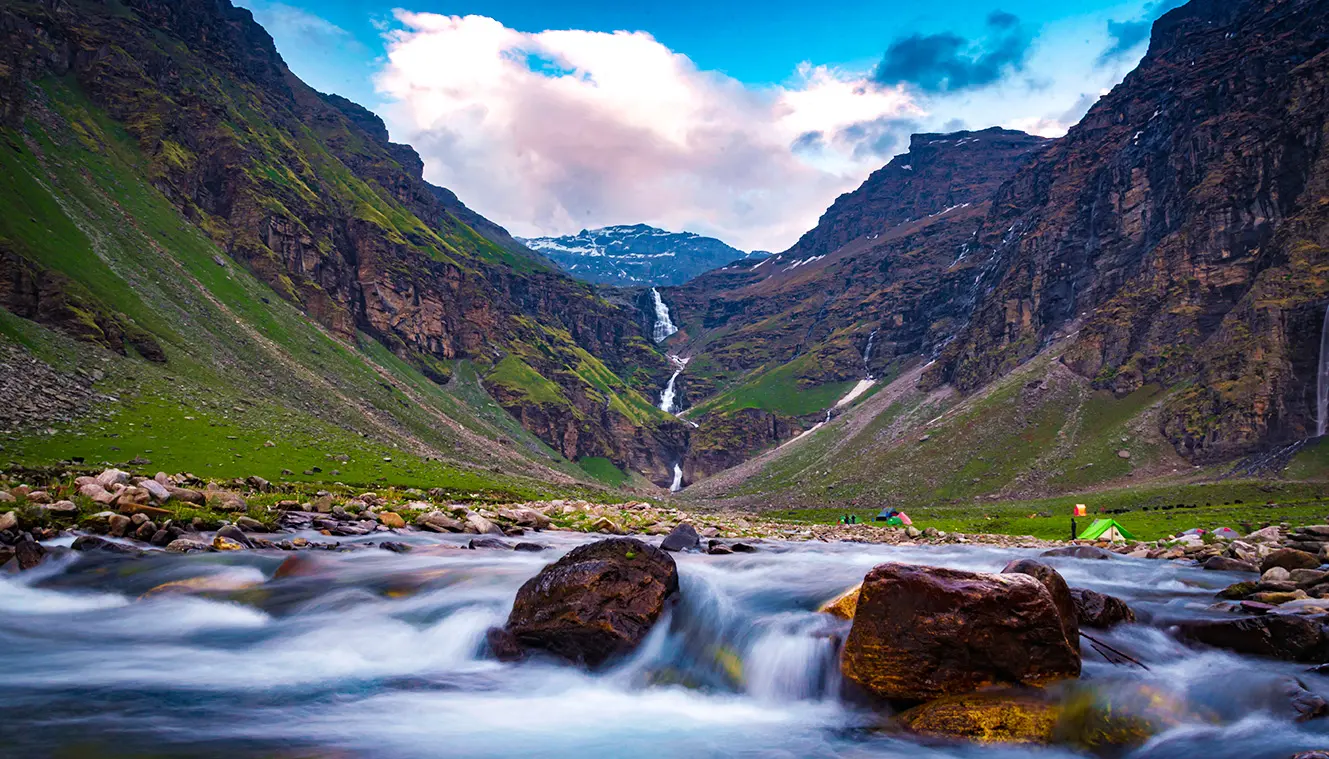
Dandreyash Thatch to Upper Waterfall
- Altitude Upper Waterfall: 4,050 m (13,300 ft)
- Trek Distance: 2 km | 3-4 hrs
- Accommodation: Campsite
Today’s trek will be short, but it is one of the most exciting and challenging sections of the journey. The day begins with an easy, relatively flat walk, giving your legs some time to warm up before the real climb begins. Soon, the ascent starts near the Lower Rupin Waterfall, and from here, the trail becomes steep and demanding.
The climb takes you along the edges of the Upper Rupin Waterfall, showcasing some of the most beautiful views of the trek. The sound of water crashing down fills the air, and you might even feel a cool mist as you get closer. The path is narrow and requires careful steps, especially as you navigate sections where loose rocks and uneven terrain make the climb more challenging.
Once you gain height, the scenery becomes even more breathtaking. Turning back, you can see Dandreyash Thatch spread out below, a tiny green meadow in the vastness of the mountains. The valley stretches far and wide, with streams and waterfalls cutting through the rugged landscape. This is one of those moments where you truly feel the scale of the Himalayas around you.
Reaching the Upper Waterfall is an achievement. The view from here is simply spectacular. The entire valley, the winding trails, and the waterfalls flowing in different directions create a picture-perfect scene. Sitting here, watching the clouds drift over the peaks and the waterfalls roaring below, you realize why this trek is so special. It's a moment to pause, take it all in, and appreciate the journey so far.
At night, you will camp here. The experience of sleeping at such high altitude, surrounded by rugged cliffs and under a sky full of stars, is memorable. The darkness falls, and the temperature starts to drop sharply, and the chilly air reminds you of the remoteness of this place. Trekkers huddle around, sharing stories over a warm meal, while the sound of the waterfall continues to echo through the valley.
Lying in your tent, wrapped in layers to fight the cold, you can hear the distant murmurs of the wind and the rhythmic roar of the cascading water. It’s a surreal experience, one that makes you feel completely disconnected from the outside world and yet, more connected to the mountains than ever before.
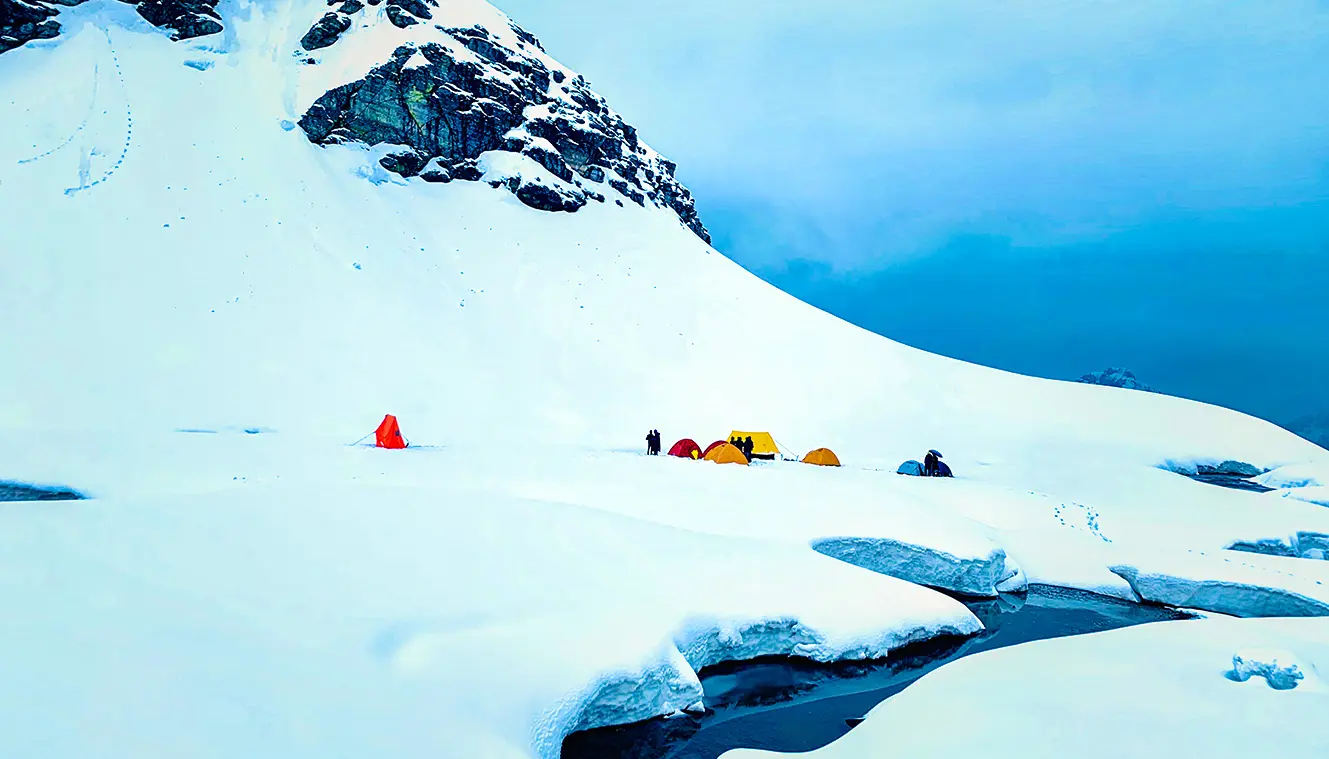
Upper Waterfall to Ronti Gad via Rupin Pass
- Altitude:
- Rupin Pass: 4,700 m / 15,350 ft
- Ronti Gad: 3,750 m / 12,300 ft
- Trek Distance: 12 km | 10-11 hrs
- Accommodation: Campsite
Today is the most awaited day on the trek as you cross Rupin Pass, the highest point of your journey. The day begins early from Upper Waterfall Camp, with a steep ascent ahead. The trail passes through rocky sections, icy patches, and narrow ridges, making it essential to walk carefully. You will encounter risky patches where you need to take each step with caution.
As you make your way up, you will reach Rattapheri, a vast open area. This spot is often used as a rest point before attempting the final steep climb to Rupin Pass. From here, the ascent gradually increases, leading you to Rupin Gully, one of the trickiest sections of the trek.
Rupin Gully is a narrow passageway between two towering rock faces. It is steep, slippery, and often covered with ice or loose scree, making it one of the most demanding sections of the trek. You will need to move carefully, using your hands for support where necessary. The wind howls through the gap, adding to the adventure of crossing it. Once you emerge from the gully, you finally step onto Rupin Pass.
At Rupin Pass, you can see the wide, open Himalayan mountains of Himachal Pradesh. In summer, the area feels lively with green patches, and you might see shepherds taking care of their sheep and goats in the high-altitude meadows nearby.
After soaking in the views, the journey is far from over. The descent to Ronti Gad is long and demanding, as you lose altitude rapidly. The trail consists of snow patches, loose stones, and uneven terrain, so maintaining a steady pace is important. As you descend, the Kinnaur Kailash peak slowly comes into view, here the trek becomes even more beautiful.
After a long trek descent, you finally arrive at Ronti Gad, your campsite for the night. This wide, open meadow has a calm and peaceful feel, making it a perfect place to rest after the day's trek. Here, the sun sets, the sky glows in shades of orange before fading into the night. The temperature drops quickly. Enjoy a warm meal under the blanket of stars, and end your day with a happy heart.
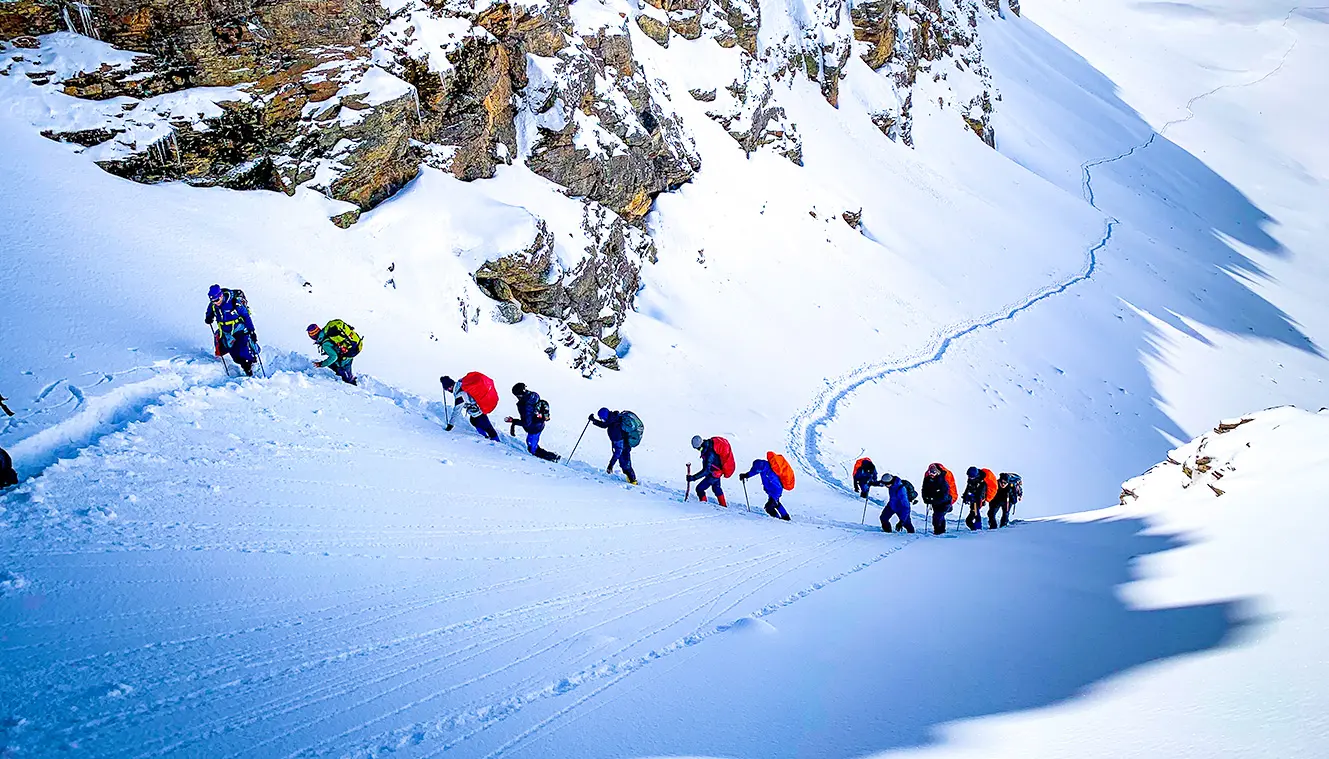
Ronti Gad to Sangla & Drive to Shimla
- Altitude Sangla: 2,650 m/ 8,700 ft.
- Trek Distance: 11 km | 5-6 hrs.
- Drive Distance: 215 km | 9-10 hrs.
The day begins with a long descent from Ronti Gad towards Sangla Kanda, a beautiful alpine meadow. The trail passes through rolling green landscapes, gradually leading you to lower altitudes where the air feels thicker and the surroundings become lusher.
While you make your way down, you’ll start noticing signs of habitation, small shepherd huts, grazing cattle, and terraced fields appearing in the distance. The descent is relatively easier on the legs compared to the steep climbs of the previous days. Here, you can soak in the changing scenery at a relaxed pace.
After a few hours of trekking, you will pass through coniferous trees before reaching Sangla town, a charming settlement in Kinnaur district, situated along the banks of the Baspa River. Sangla is known for its apple orchards, traditional wooden houses, and rich Kinnauri culture. The town is surrounded by mountain views, which makes it a perfect spot to conclude your trek.
Here, you can take some time to explore the local area, interact with the friendly locals, or simply rest after completing your adventure. The accomplishment sinks in as you step into civilization after days of trekking through high-altitude terrain.
Drive to Shimla
Without much delay, you will board a vehicle for the long drive to Shimla. You will drive through mountain roads, deep valleys, and traditional Himachali villages. It’s a great opportunity to reflect on the journey, reliving the unforgettable moments of the trek.
By the time you reach Shimla, the trek officially comes to an end, but the memories of crossing Rupin Pass, camping under starlit skies, and witnessing the raw beauty of the Himalayas will stay with you forever.
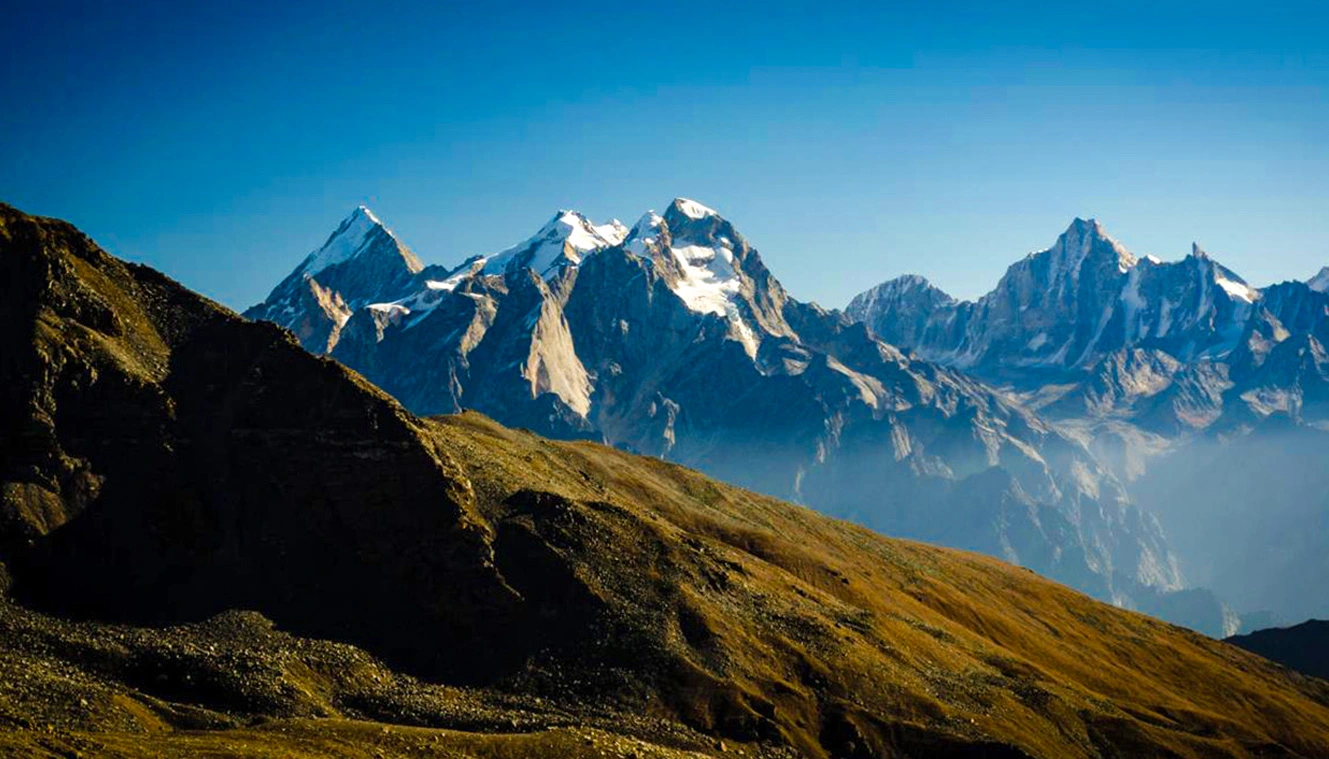
Day-1: Arrival In Bawta
- Altitude Bawta: 2,350 m/ 7,700 ft.
- Drive Distance: 195 km | 8 - 9 hr.
Day-2: Bawta to Jakha
- Altitude Jakha: 2,750 m/ 9,000 ft.
- Trek Distance: 5 km | 4 hrs.
Day-3: Jakha to Dandreyash Thatch
- Altitude Dandreyash Thatch: 3,550m / 11,700ft.
- Trek Distance: 11 km | 8 hrs.
Day-4: Rest and Acclimatization Day at Dandreyash Thatch
Day-5: Dandreyash Thatch to Upper Waterfall
- Altitude Upper Waterfall: 4,050 m / 13,300 ft)
- Trek Distance: 2 km | 3-4 hrs
- Accommodation: Campsite
Day-6: Upper Waterfall to Ronti Gad via Rupin Pass
- Altitude:
- Rupin Pass: 4,700 m / 15,350 ft
- Ronti Gad: 3,750 m / 12,300 ft
- Trek Distance: 12 km | 10-11 hrs
- Accommodation: Campsite
Day-7: Ronti Gad to Sangla & Drive to Shimla
- Altitude Sangla: 2,650 m/ 8,700 ft.
- Trek Distance: 11 km | 5-6 hrs.
- Drive Distance: 215 km | 9-10 hrs.
Rupin Pass Trek Graph
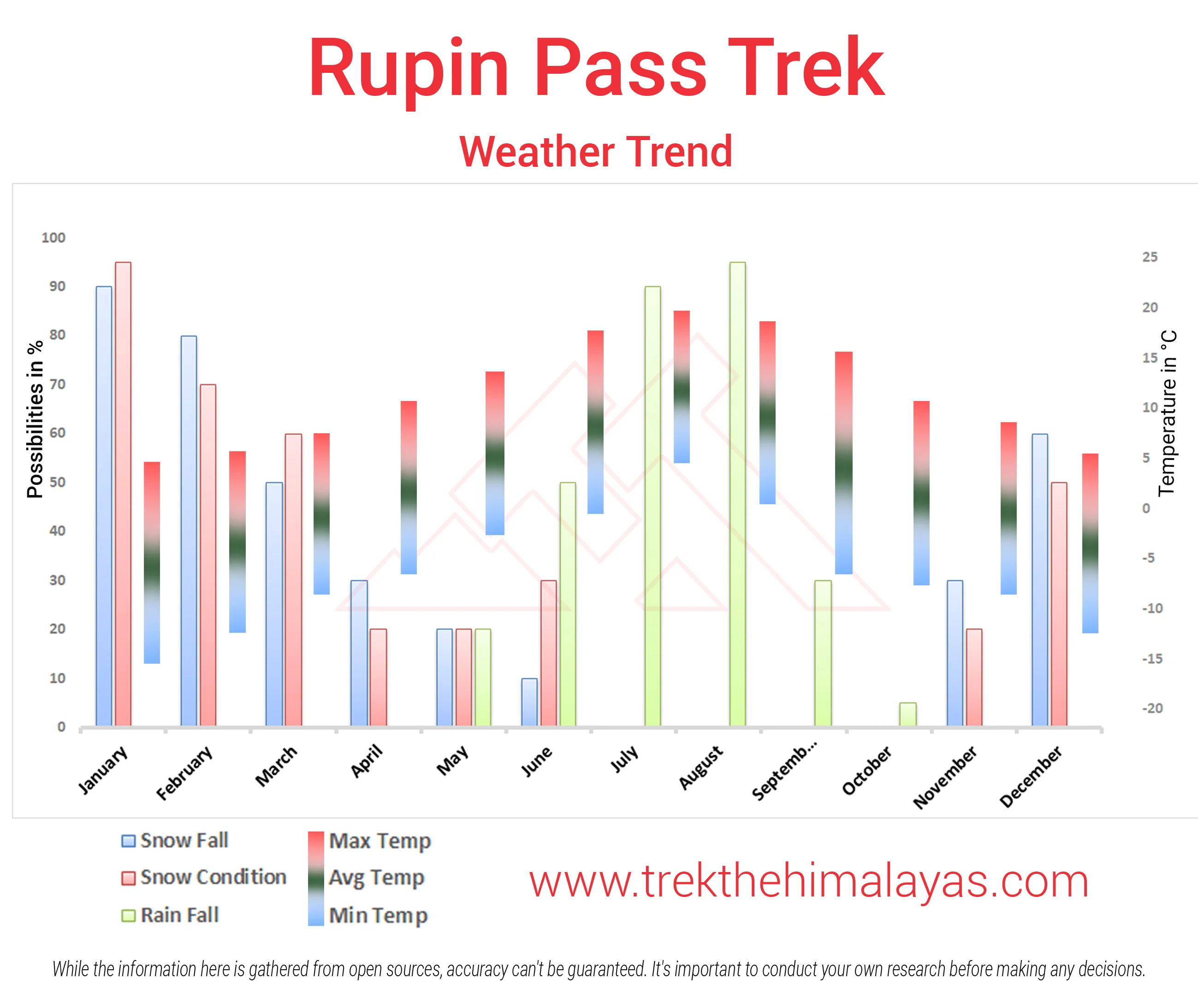

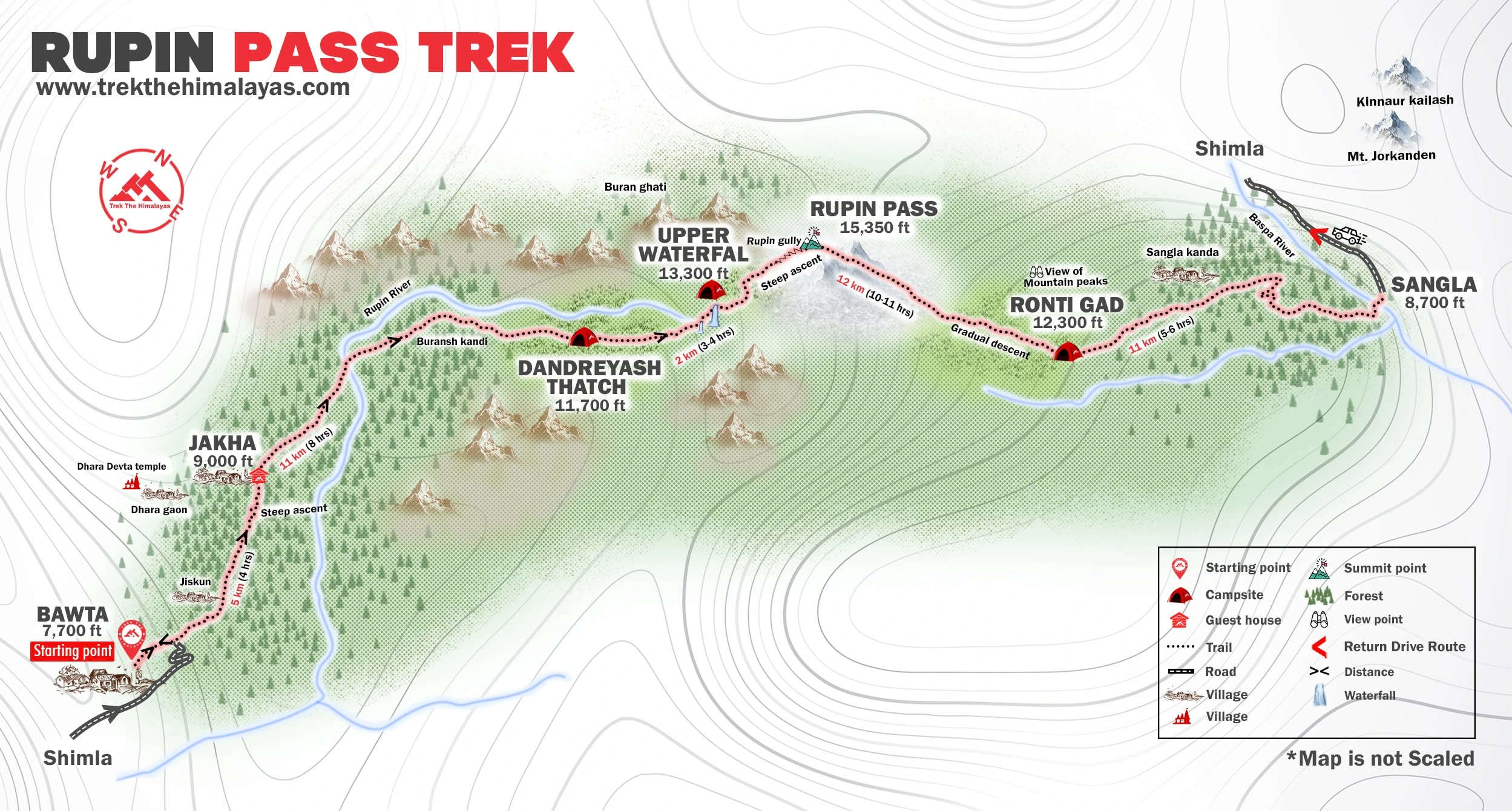
- Pulse rate at rest must be in between (60 to 100 beats per minute).
- Blood Pressure Reading must be in between (DIASTOLIC 75 – 85, SYSTOLIC 100 - 130 mm Hg).
- Respiratory rate at rest must be in between (12 to 20 breaths per minute).
- Should not have Liver and kidney issues.
- Should not have Diabetes Mellitus, Bronchial Asthma, Heart problems, Hypertension, etc.
- No pacemaker implant.
- People with Sinus issues, Epilepsy please contact to trek coordinator before booking the trek.
- If your BMI is not normal, Please contact our Trek coordinator before Trek booking.
Medical & Disclaimer Form (Mandatory Documents) Click here to download Medical & Disclaimer Form
- Government Employees can avail the benefit of Special Casual Leave (SCL) when they join us for a trekking expedition. As per the rules of the Pay Commission, Special Casual Leave can be availed for up to 30 days in a calendar year for trekking/mountaineering expeditions through a registered organization. Trek The Himalayas is a registered adventure tour operator by the Indian Mountaineering Foundation (IMF) and the Ministry Of Tourism (MOT).
- Trekkers have to apply for leave at least 20 days before the trek departure date.
- This service is exclusive to Indian government employees and is applicable only for treks within India.
- Do mail at info@trekthehimalayas to apply and mention your booked trek date and trek name.
- Junior trekkers (below 15 years) should have a company of parents/guardians.
- Trekkers between 15 to 18 years can come solo with the disclaimer form signed by parent/guardian.
- Medical & Disclaimer Form (Mandatory Documents) Click here to download Medical & Disclaimer Form
Important Links
- Mandatory Documents to Bring on A Trek Click Here.
- How to pay Add-ons, Submit Medical Forms, and Dietary Preferences Click Here to watch Video
How To Reach
It is essential for everyone to arrive at Shimla (05:30 am)
Meeting
Place: Shimla Old Bus Stand.
Once you have reached Shimla, TTH will manage the rest of your travel arrangements, if you have opted for TTH's pick-up service, you can select this option during the booking process by adding it as an add-on (book it at least 10 days before trek date)
It is advisable to reach Shimla a day before to avoid any kind of delays.
Options to reach Shimla:
First, you can arrive at Chandigarh, Delhi, Kalka, or Shimla airport. The journey from these locations to Shimla is explained below.
1. Take overnight bus to Shimla from Delhi or Chandigarh, taking a bus from Chandigarh is the most ideal option.
-Chandigarh to Shimla Bus Stand : 120 km | 4 hr.
-Delhi to Shimla Bus Stand : 350 km | 10 hr.
( We always recommend going for the govt. Buses over the private ones outside the bus station as based on the experience we have found that there are very high chances of delay involved with private buses. Also, govt. Buses are always more reliable. Whichever bus you choose, just make sure to reach Shimla at least by 05:30 am. )
2. Take a Train to Kalka and drive to Shimla. One can take the pleasure of a toy train, If you're arriving by Train, then come one day in advance.
3. Take a flight to Shimla airport (Jubbarhatti airport) (22 km, 50 min). If you're arriving by air, then come one day in advance.
The designated drop-off point is Shimla old bus stand.
Reach Shimla by 11:00 pm to 1:00 am, Please arrange your hotel and make further bookings in Shimla accordingly.
It's highly advisable to keep a buffer day in your travel plan. If the buffer day is not needed, it can be used to explore Shimla.
( If you prefer to travel independently, you can either take a government bus or book a private cab. Your trek coordinator will provide guidance on how to arrange for the bus or cab booking. )
TTH offers comfortable transportation through Tempo Traveler, Bolero, or equivalent vehicles. If you wish to upgrade your mode of transportation, please contact your trek coordinator for further assistance.
.webp)
Cost Terms
Inclusion
1. Accommodation (as per the itinerary):
- Homestay (dormitory with ground mattress.)
- Camping (Twin sharing basis).
2. Meals (Veg + Egg):
- All meals from Day 1 Dinner to Day 7 breakfast as per the itinerary.
3. Support:
- 1 Versatile base camp manager handles communication and deploys extra manpower in emergencies.
- 1 Mountaineering & First aid qualified professional trek Leader.
- 1 Experienced high altitude chef.
- Local experienced guides (Number of guides depending on the group size).
- Enough support staff.
4. Trek equipment:
- Sleeping bag, Sleeping liners (if required), mattresses, and Utensils.
- 3 men all season trekker tent (twin sharing), Kitchen & Dining tent, Toilet tent.
- Camping stool, Walkie talkie.
- Ropes, Helmet, Ice axe, Harness, Gaiters & crampons (if required).
5. First aid:
- Medical kit,Stretcher,Oxygen cylinder,Blood pressure monitor,Oximeter,Stethoscope.
6. Mules/porters to carry the central luggage.
7. Cloakroom facility available at pick up point for additional luggage.
9. All necessary permits and entry fees, up to the amount charged for Indian.
10. Services from Bawta to Sangla.
11. Trek Completion Certificate.
Exclusion
1. Insurance (Mandatory).
2. Food during the transit.
3. Any kind of personal expenses.
4. Mule or porter to carry personal luggage.
5. Emergency evacuation, hospitalization charge or etc.
6. Transportation (as per the itinerary):
- Transportation from Shimla to Bawta & Sangla to Shimla.
6. Anything not specifically mentioned under the head Inclusion.
Things can be provided on demand and availability (participant has to pay extra for these things).
1- Satellite phone/set phone - is a type of mobile phone that connects via radio links via satellites orbiting the Earth instead of terrestrial cell sites like cellphones. Therefore, they can operate in most geographic locations on the Earth's surface.
2- Gamow/PAC HAPO Bag (Portable Hyperbaric Bag) - is a unique, portable hyperbaric chamber for the treatment of acute mountain sickness (AMS), also known as altitude sickness.
3- AEDs (Automated External Defibrillators) - are portable life-saving devices designed to treat people experiencing sudden cardiac arrest, a medical condition in which the heart stops beating suddenly and unexpectedly.
Cancellation Terms
To request a cancellation, please email us at info@trekthehimalayas.com using your registered email ID.
Cancellations prior to 25 days from the start of the Trip
Refund Options
- 5% deduction of trek fee
- 100% cash voucher for any trip till one year
- Transfer your trek (any trek, any date) to your friend
Cancellation between 24 days and 15 days to the start of the Trip
Refund Options
- 30% deduction of trek fee
- 100% cash voucher for same trip till one year
- 85% cash voucher for any trip till one year
- Transfer your trek (same trek, any date) to your friend
Cancellation between 14 days and 10 days to the start of the Trip
Refund Options
- 50% deduction of trek fee
- 80% cash voucher for same trip till one year
- 70% cash voucher for any trip till one year
- Book the same trek, in the same season, with any other batch
- Transfer your trek (same trek, any date) to your friend
Cancellation less than 9 days to the start of the trek.
Refund Options
- No cash refund
- 20% cash voucher for the same trip till one year
- 10% cash voucher for any trip till one year
- Transfer your trek (same trek, same date) to your friend
Cancellation Policy (Emergency Cases):
In case of a death in the immediate family (parents, siblings, spouse, children) or if the trekker is hospitalized (min. 48 hours) or suffers a fracture (leg/arm) within a week before the trek, even if canceled a day before:
90% refund in cash & 10% as a voucher (valid for 1 year, for any India trek)
Valid documents required. We’re here to support you during tough times.
Note:
- Change of trek batch is dependent on the availability of seats in the batch
- In case of transferring a trek to a friend, he/she should satisfy all the mandatory requirements put forward by TTH
- TTH holds the right to change/cancel the policies, without prior notice
Booking and Payments
- The Participant is responsible for verifying the accuracy of all details, including Trip dates and personal documentation, at the time of booking.
- Payments must be made in accordance with the timelines and instructions provided by TTH. Late payments may result in cancellation of booking without refund.
- In the event of a cash refund, only the portion of the payment made in cash shall be eligible for refund in cash. Any booking made using voucher, discounts, promotional codes, or through any non-cash mode of payment shall not be eligible for a cash refund under any circumstances.
- Refunds, if applicable, shall be processed within 15–30 working days of confirmation.
- Voucher Terms
- This is a non-transferable voucher
- The voucher cannot be merged with any other offer of Trek The Himalayas
- The voucher is valid for Trek booked directly with Trek The Himalayas in India
- To avail the voucher please use your register phone number or e-mail id
- All the other Terms of booking a trek with Trek The Himalayas are applicable to the voucher
Itinerary and Modifications
- TTH reserves the right to modify, shorten, or cancel any part of the Trip due to transportation delays, weather, health emergencies, or other unforeseen circumstances including Force Majeure.
Cancellations and Refunds
- No refunds or vouchers, partial or otherwise, shall be provided for voluntary withdrawal, non-utilisation of services, or removal from the Trip.
- If TTH cancels the Trip before arrival at the designated pick-up point due to unforeseen circumstances or Force Majeure, the Participant may choose from:
- An alternate Trip/date.
- A credit voucher valid for one (1) year.
- Transfer to another Trip, with cost differences payable by the Participant.
- If the Trip is abandoned post-arrival at the designated pick-up point, no cash refund or voucher shall be issued. The Trek Again Policy may apply at TTH’s discretion.
- TTH shall not be liable for any associated travel costs such as flights, accommodation, or visa fees.
Force Majeure
- Events beyond its control including but not limited to earthquakes, landslides, strikes, curfews, war, pandemic, government restrictions, heavy rainfall or snowfall, windstorms, road blockages, trail disruption, or withdrawal of permits, TTH shall not be held liable for any cancellation, delay, or service modification caused by Force Majeure.
Trek Essentials
Rent EquipmentPDF Of Trek Essential Download
| Backpack with rain cover | (50 - 60 ltr) with comfortable shoulder straps |
| Day pack with rain cover | 20 - 30 ltr (If off-load opted) |
| Walking stick | Advisable (At least one) |
| Water Bottle / Hydration pack | 2 bottles of one liter each, People who use hydration pack 1 hydration pack and 1 bottle of one liter, Carry at least one thermos flask. |
| Small size tiffin/lunch box | 1 Nos |
| Snacks | Energy bars, dry fruits, electral/ors |
| Personal Medical Kit | Consult your doctor |
| T-Shirt (Synthetic quick dry) | 1 Full & 2 Half sleeves |
| Fleece T-shirt | 1 Nos |
| Wind stopper / Fleece jacket | 1 Nos |
| Windproof Jacket | 1 Nos |
| Down feather / Hollow jacket | 1 Nos |
| Thermal inner (Upper and Lower) | 1 Pair |
| Trek Pant (Synthetic quick dry) | 2 Nos |
| Wind stopper / Fleece Pant | 1 Nos |
| Waterproof gloves | 1 Pair |
| Fleece / woollen gloves | 1 Pair |
| Poncho / waterproof Jacket and pant | 1 Nos |
| Sunscreen | 1 Nos |
| Moisturiser | 1 Nos |
| Chap-stick / Lip balm | 1 Nos |
| Toothbrush and toothpaste | 1 Nos |
| Toilet paper & Wipes | 1 Nos |
| Soap / hand sanitizers | 1 Nos |
| Antibacterial powder | 1 Nos |
| Quick dry towel | 1 Nos |
| Head torch | 1 Nos. (Avoid Hand torch) |
| Sun Cap | 1 Nos |
| Woolen cap | 1 Nos. |
| Balaclava | 1 Nos. |
| Buff / Neck-gaiters | 1 Synthetic & 1 Woollen |
| Sunglasses | UV with dark side cover, People who wear spectacles - (A)- Use contact lenses | (B)- Photo chromatic glasses |
| Trekking shoes | 1 Pair (Waterproof, high ankle, good grip) |
| Floaters / flip-flops | 1 Pair |
| Cotton socks | 6 pairs |
| Woollen socks | 1 pairs |
| Gaiters | 1 Pair (TTH provides when required) |
| Micro spikes | 1 Pair (TTH provides when required) |
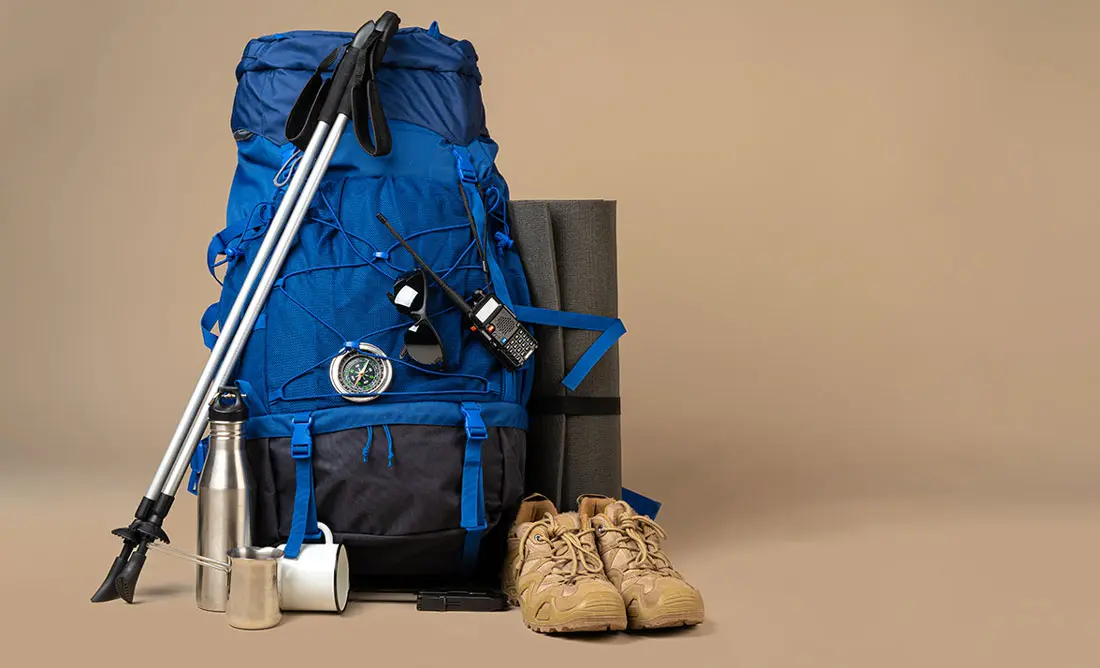
Frequently Asked Questions(FAQ)
To register with TTH, visit our website - www.trekthehimalayas.com and create your account. To create your account you will need to use your email address and fill in all the details, set your unique password and your account is ready to use.
- To book a trek with TTH, you first need to register with us and create an account.
- Choose the trek that you want to do and click on available dates.
- You will land at the login page, fill in the required details.
- Add Participants, choose add-on services click on the Pay now button, choose your preferred payment method, and make the payment. TTH accepts multiple payment options, including credit/debit cards, net banking, and UPI.
- You will receive a confirmation email from TTH with all the necessary details about the trek, including the meeting point, transportation, accommodation, and other important instructions.
- Click Here to watch Video
please send an email to us at info@trekthehimalayas.com or reach out to the numbers provided in the Help and Support section of your Trek Page. We will ensure that your issue is promptly resolved.
To book services such as off-load luggage and transportation, you can find them listed as add-ons. These additional services can be booked at the time of your initial booking. If you miss booking add-ons during the initial reservation, you can log in anytime and easily book 4 days before the departure date add-ons through the platform.
If you have booked the wrong trek or selected the wrong date, don’t worry! You can contact us at +91 9368882322 (Monday to Saturday, 10 AM to 10 PM) or email us at info@trekthehimalayas.com. You can also discuss this with your trek coordinator. Please make sure to inform us at least 10 days before the departure of your trek. Only then can we help you reschedule or arrange another trek for you.
We recommend visiting our "Suggest Me a Trek" page. By filling out the form, our experts will contact you with the best possible trek options based on your preferences and experience level. Alternatively, you can reach out to us via email at info@trekthehimalayas.com or give us a call using the numbers provided on our website for personalized assistance and recommendations.
Family treks differ from regular treks by focusing on ease of difficulty, offering shorter durations for younger participants, Kid-friendly and easily digestible foods, child-friendly activities, maintaining a higher guide ratio for diverse age groups, and implementing additional safety measures for families.
Family Trek with Kids recommendation Only Dayara Bugyal and Chopta Chandrashila Trek.
Minimum age for TTH treks is typically 7 years, though this may vary depending on the specific trek.
Yes, you can take a kids to a high-altitude trek with a parent. Discuss with a trek expert before booking a trek.
- Junior trekkers (below 15 years) should have a company of parents/guardians.
- Trekkers between 15 to 18 years can come solo with the disclaimer form signed by parent/guardian.
- Medical & Disclaimer Form (Mandatory Documents) Click here to download medical and disclaimer form
Physical Fitness: Ensure your child is physically fit. Engage them in regular exercise, outdoor activities, and hikes to build stamina and endurance. Hydration: Emphasize the importance of staying hydrated at high altitudes. Encourage your child to drink water regularly, even if they don't feel thirsty. Proper Nutrition: Provide a well-balanced diet with sufficient carbohydrates for energy and foods rich in iron to prevent altitude sickness. Adequate Sleep: Ensure your child gets enough sleep in the days leading up to the trek. Quality rest is crucial for altitude adaptation. Educate on Altitude Sickness: Teach your child about the symptoms of altitude sickness, such as headache, nausea, and dizziness. Encourage them to communicate any discomfort immediately. Appropriate Clothing and Gear: Dress your child in layers to adjust to changing temperatures. Ensure they have appropriate trekking gear, including sturdy footwear. Positive Mindset: Foster a positive mindset. Encourage your child, and let them know it's okay to take breaks when needed. Medical Check-Up: Schedule a medical check-up before the trek to ensure your child is fit for high-altitude activities. Consult with a healthcare professional about any potential health concerns.
TTH takes special care to provide wholesome and nutritious food for children on treks. Here are some of the foods that are typically served for children:
Breakfast: For breakfast, TTH serves a variety of options like porridge, cornflakes, bread, butter, jam, honey, boiled eggs, omelettes, and pancakes. Children can choose from these options to fuel themselves for the day's trek.
Lunch: For lunch, TTH serves lunch which includes rotis, vegetables, rice, dal, and salad. The rotis are usually made fresh on the trek and are a good source of carbohydrates. The dal and vegetables provide protein and other essential nutrients.
Snacks: TTH provides healthy snacks like fresh fruits, dry fruits, energy bars, cookies, and biscuits to keep the children energized throughout the day.
Dinner: For dinner, TTH serves a hot and wholesome meal which includes soup, rice, dal, vegetables, and a non-vegetarian dish (if requested in advance). Children can also choose from a variety of desserts like custard, jelly, and fruit salad.
Dietary requirements: If a child has any special dietary requirements, TTH can cater to those needs as well. For example, if a child is lactose intolerant or allergic to nuts, the kitchen staff can make arrangements to accommodate those requirements.
Choosing the right trek for a beginner can be a bit overwhelming as there are many factors to consider such as distance, elevation gain, terrain difficulty, weather, and time of year. Here are some tips that can help you choose the right trek for a beginner:
1. Determine fitness level: Assess the fitness level of the beginner to understand their physical capabilities. This will help you select a trek that is challenging but not too difficult.
2. Choose a well-traveled trail: A well-traveled trail will have more amenities such as signposts, water stations, and shelter. It is also safer as there will be other hikers on the trail.
3. Consider the length of the trek: For beginners, it is recommended to start with a shorter trek that can be completed in a day or two. This will help them get acclimatized to trekking and build their confidence.
4. Look for gradual elevation gain: Choose a trek with a gradual elevation gain rather than steep ascents. This will make the trek easier and more enjoyable.
5. Check the weather: Check the weather forecast before selecting a trek. Avoid treks during the monsoon season or winter when the trails can be slippery or dangerous.
6. Research the trail: Read about the trail to get an idea of the terrain, altitude, and difficulty level. This will help you select a trek that is suitable for the beginner.
7. Consult with an expert: If you are unsure about which trek to choose, consult our trek expert Mr. Nitin (+91 70600 59773) between 10 AM to 6 PM (Tuesday - Friday). Mr. Nitin will provide you valuable advice and guidance.
Overall, it is important to choose a trek that is enjoyable, challenging but not too difficult, and suitable for the beginner's fitness level and experience.
It is not recommended for a beginner to choose a difficult Himalayan trek. Trekking in the Himalayas can be physically and mentally challenging, especially if you are not used to the high altitude, steep slopes, and rugged terrain. Choosing a difficult trek without the proper experience, fitness level, and preparation can be dangerous and put you at risk of altitude sickness, injury, and other hazards.
If you are a beginner, it is recommended to start with an easier trek and gradually build up your skills and experience. This will help you understand the challenges of trekking in the Himalayas, and also prepare you physically and mentally for a more difficult trek in the future. It is also important to choose a trek that matches your fitness level, experience, and interest.
There is no specific age limit for a beginner trekker. However, it is important to consider your physical fitness, health condition, and personal interests before embarking on a trek. Trekking in the Himalayas can be physically and mentally demanding, and requires a certain level of physical fitness and endurance.
If you have any pre-existing medical conditions or are above a certain age, it is recommended to consult with a doctor before embarking on a trek. It is also important to listen to your body and take breaks as needed during the trek to prevent exhaustion or injury.
We recommend visiting our "Suggest Me a Trek" page. By filling out the form, our experts will contact you with the best possible trek options based on your preferences and experience level. Alternatively, you can reach out to us via email at info@trekthehimalayas.com or give us a call using the numbers provided on our website for personalized assistance and recommendations.
Yes, you can join the trek. We have fixed departure groups where you can simply book your trek and we will take care of curating a group.
Before you start the trek, it is recommended that you make all the necessary phone calls as during the trek you may or may not receive network coverage, once you come back to the Base Camp, you can reconnect with your family via phone once again. You can share your trek coordinator contact detail with your family members to get the latest updates about your trek batch.
At TTH, we provide wholesome and nutritious meals during the trek. The food is vegetarian and includes a variety of dishes such as rice, dal, vegetables, chapati, paratha, pasta, noodles, and soup. We also offer snacks such as biscuits, and salty, and dry fruits during the trek. Special dietary requirements such as vegan, gluten-free, or Jain food can also be arranged if informed in advance.
If you are allergic to some foods, you need to let us know in advance so that we can make arrangements accordingly.
TTH is a trekking company that prioritizes the safety of all its participants, including women trekkers. We have a comprehensive safety system in place, which includes a dedicated team of experienced and trained trek leaders and support staff who are equipped to handle emergency situations and provide first aid.
TTH also takes specific measures to ensure the safety and comfort of women trekkers. They have a separate tent accommodation for women trekkers, female trek leaders, and support staff. They also provide separate toilet facilities for women and encourage a safe and respectful environment for all trekkers.
Moreover, TTH has a strict policy against any kind of harassment and has a zero-tolerance policy towards such incidents. They have a designated Internal Complaints Committee (ICC) to investigate and address any complaints related to harassment or misconduct. Overall, TTH has a good reputation for safety and responsible trekking practices, and women can feel comfortable and safe while trekking with them.
In case you are the only women in the group, we provide a single sleeping arrangement. Also, during the trek, the trek leader will always remain by your side to provide optimum safety and reassurance.
You can reach out to the trek coordinator to inquire about the number of female trekkers and their respective states who have booked the trek. Please note that the trek coordinator cannot disclose personal details of any trekker. Once you've confirmed your booking, a WhatsApp Group will be created for all the trekkers in your batch. This allows you to connect with fellow trekkers before the trek begins.
While many of our treks are led by female trek leaders, however, it is not possible to know which trek leader is assigned to which group. But nonetheless, whether the trek leader is male or female you can be completely assured of your safety and security with us.
Yes, it is possible to trek with periods. However, it is important to take some extra precautions and preparations to ensure a comfortable and safe trekking experience. Here are some tips that can help you trek during your period:
1. Use menstrual hygiene products that you are comfortable with, such as tampons, pads, or menstrual cups. It is recommended to carry enough supplies for the entire duration of the trek.
2. Pack wet wipes, hand sanitizer, and plastic bags to dispose of used hygiene products.
3. Wear comfortable and breathable clothing that allows for easy movement and reduces friction. Avoid wearing tight or restrictive clothing that can cause discomfort.
4. Carry pain relief medication, such as ibuprofen or acetaminophen, in case of menstrual cramps.
5. Stay hydrated and maintain a balanced diet to support your energy levels and overall health.
6. Take breaks as needed and listen to your body. If you feel uncomfortable or experience any unusual symptoms, seek medical attention immediately. It is also recommended to consult with a doctor before going on a trek during your period, especially if you have a pre-existing medical condition or are taking medication.
By taking necessary precautions and being prepared, you can have a safe and comfortable trekking experience even during your period. We provide proper disposal facilities for sanitary pad disposal during the trek.
We offer three person tents with twin-sharing for optimum comfort. A woman trekker will share a tent with another woman trekker and if you are the only woman in the group, you will be given a single accommodation for your comfort and privacy.
Yes, we do provide gears on rent. You can book it using you TTH account directly.
Mountaineering qualified Experienced and first aid certified Trek Leader, First Aid Certify local guide, Cook, helpers and supporting staff.
People suffering from Bronchitis, Asthma, High blood pressure, Epilepsy (got faints), TB , Heart problem or on higher BMI side are strictly not allowed to go on any Himalayan trek. Apart from this if you had any medical history, please let us know.
No. Alcohol and smoking isn’t allowed while on trek. It is totally misconception that it will keep you warm. Your body need to acclimatize properly and for that eat properly and drink enough water; these things will keep you warm.
Toilet tents provide a convenient solution for answering nature's call in the great outdoors. Dry toilets, in particular, offer a highly sanitary approach. By digging a pit and utilizing mud and a shovel, you can easily cover up your waste. This method ensures cleanliness and hygiene while camping or exploring in the forest.
Remember to pack essential toiletries to complete your outdoor bathroom kit and maintain proper personal hygiene during your adventures. With these practices in place, you can enjoy nature while also respecting it.
Layer Up From Head To Toe
Eat Full Meals, never sleep empty stomach
You can keep warmee (if you’re more susceptible to cold).
Use sleeping bag in right way and don’t leave free space in sleeping bag.
For upper body
– Thermal layer
– T-shirt (full-sleeves)
– Fleece T-shirt (for extreme colds)
– Fleece layer
– Thick Jacket/Down Jacket
– Waterproof or Windproof layer (outermost layer, when it is snowing or raining)
- For Lower Body
– Thermal layer
– Hiking pants (normal) or Winter hiking pants
Based on how warm you feel you can skip any of the above layers. Your outer later should be windproof since it is windy at high altitude.
The idea behind layering is that the more insulation you have the less cold you feel, and instead of wearing a very thick jacket if you wear multiple layers, your body will be better insulated against the cold.
Yes, we provide micro spikes and gaiters, if required.
Mandatory documents: 2 xerox of ID having address (addhar card/driving license), 2 Passport size photographs, hard copy Medical form signed & sealed by doctor, disclaimer form sign by trekker and high altitude insurance.
No. We don’t but we can suggest you good hotel/Stay nearby pick up location.
Yes, trekker must carry 2 water bottles 1 litre each so they can refill it at campsite for drinking and keep themselves hydrate.
You should buy shoes which has these three features –Good grip, Ankle Support and additional water resistant layers. Generally, we advise Quechua Trek 100, MH 500 and MH 100.
No one is forced to go on. There is always enough staff to split the party according to need and regroup later at the camp. Most people have no trouble reaching the highest campsite. If some members decide not to climb the final distance they can wait for the climbers to come back down the same way or take a lateral path to the descent route.
Trek The Himalayas is the safest and most trusted trekking organization in India. Our deep expertise and commitment ensure that each trekker can fully immerse in the Himalayan beauty while experiencing a well-organized and memorable journey. We are proud to be recognized among the best trekking companies in India and have been awarded the PHD Samman Award two years consecutively for Best Adventure Tour Operator. Our founders, themselves are proficient mountaineers and belong to the hilly states of India. At TTH we follow all the safety protocols. Our Trek Leaders are expertly trained in First Aid and Acute Mountain Sickness (AMS) management. The extensive experience is a key factor in establishing us as the best trekking company in India.
Explore the best trekking companies in India and see what sets them apart.Yes, Trek The Himalayas (TTH) provides customized trekking packages, and premium trek packages, apart from fixed departures tailored to your preferences and needs. We understand that each trekker has unique interests, timeframes, and fitness levels, so we are happy to design a customized trek package that aligns with your goals. If you are seeking a specific experience, such as camping under the stars, a photography-focused trek, or an itinerary that includes cultural and heritage sites, our team can help create the ideal trekking package for you.
With a customized trek, you have the flexibility to choose aspects like trek difficulty, duration, group size, and even special add-ons like guided tours of nearby villages or extended camping nights at scenic locations.
Our customization options are ideal for families, groups, corporate teams, and solo adventurers looking for a tailored journey through the Himalayas.
Yes, you need special permits for Trekking in India, especially in protected or restricted areas. In states like Uttarakhand, Himachal Pradesh, and Ladakh, trekkers may need to obtain permits from local authorities or forest departments before starting their journey. For international trekkers, special permits like the Inner Line Permit (ILP) are required for regions such as Ladakh and Arunachal Pradesh. To make the process easier, Trek The Himalayas assist adventurers in obtaining all the necessary paperwork and permits, ensuring a hassle-free trekking experience.
Trek The Himalayas is committed to promoting Sustainable Tourism and Eco-Friendly Tourism by following responsible trekking practices and encouraging our trekkers to do the same.
We have introduced impactful initiatives like Heal Himalaya and Leave No Trace. Through these programs, we regularly organize cleaning drives along trekking routes and surrounding areas to keep the trails free from litter. Our team carries trash bags during every trek, ensuring that all waste collected from the slopes is brought back to the base and disposed of properly. We also take active steps to reduce plastic waste by completely avoiding the use of single-use plastics and encouraging our trekkers to do the same. Small changes like carrying reusable bottles and eco-friendly alternatives can make a big difference in protecting the environment.
By choosing to trek with us, you become a part of this movement toward responsible and sustainable trekking.
Yes, Trek the Himalayas provides trekking tours to well-known pilgrimage sites, including Kailash Mansarovar Yatra, Adi Kailash Yatra, Char Dham Yatra, and Panch Kedar.
Trekking in India offers something for everyone, from easy trails for beginners to tough and challenging routes. If you're planning to go for high-altitude or difficult treks like Kang Yatse or Pin Parvati, it's better to have some prior trekking experience.
However, if you're new to trekking, there are many beautiful and beginner-friendly options to start with, like Dayara Bugyal, Ali Bedni, Chandrakhani Pass, Sandakphu, Surya Top, and many others. Your preparation depends on the trek you choose. Easier treks need basic fitness, while tougher ones require more training and experience.
India offers a wide range of beautiful treks, and the best one really depends on your fitness level, experience, and what kind of views or adventure you’re looking for. Here are some of the most popular and well-loved treks:
Sandakphu Trek, Sikkim/West Bengal – Famous for views of four of the five highest peaks in the world.
Dayara Bugyal Trek, Uttarakhand – A perfect choice for beginners with scenic meadows and easy trails.
Ali Bedni Bugyal Trek, Uttarakhand – Known for its lush meadows and close views of Mount Trishul and Nanda Ghunti.
Pin Bhaba Pass Trek, Himachal Pradesh – A stunning crossover trek with changing landscapes.
Kashmir Great Lakes Trek, Jammu and Kashmir – One of the most beautiful treks in India, with alpine lakes and valleys.
Ranthankharak Trek, Uttarakhand – A less-crowded trail offering peace and beautiful mountain views.
Valley of Flowers Trek, Uttarakhand – A UNESCO World Heritage Site, famous for its vibrant blooms during monsoon.
Choose the one that matches your fitness and interest, and you’re in for an unforgettable experience.
Deciding which Indian state has the "best" trekking is tough, as it really depends on what you're looking for. However, Himachal Pradesh and Uttarakhand consistently stand out as top contenders, both offering incredible variety and stunning Himalayan scenery.
Himachal Pradesh is a trekker's paradise, boasting the Dhauladhar, Pir Panjal, Shivalik, and Zanskar ranges. Uttarakhand, often called the "Land of Gods," also has an abundance of beautiful trails. Its Garhwal and Kumaon regions feature iconic treks through lush alpine meadows that turn into snowy landscapes in winter.
Apart from Himachal and Uttarakhand Sikkim (with views of Kanchenjunga) and parts of Jammu & Kashmir (like the Kashmir Great Lakes trek) also offer unique and exceptional experiences. Ultimately, the "best" state depends on your preference for lush valleys, spiritual paths, or remote mountain adventures.
For beginners, one of the best trekking options is the Nag Tibba trek in Uttarakhand. It’s an easy to moderate trek, perfect for first-timers. The trail offers beautiful mountain views, takes just a couple of days, and gives a good idea of what trekking in the Himalayas feels like.
Other beginner-friendly treks that are slightly longer but still manageable include Kedarkantha, Bhrigu Lake, Kuari Pass, and Dayara Bugyal. These treks are not very tough and give you more time in the mountains, with amazing scenery and a great learning experience.
To start trekking in India, follow these simple steps:
1. Choose an easy trek: Pick a beginner-friendly trek that matches your fitness level. Go for shorter and well-marked routes that don’t have very steep climbs or high altitudes. Treks like Chopta–Chandrashila, Nag Tibba, or Dayara Bugyal are great options to begin with.
2. Work on your fitness: Start getting fit a few weeks before your trek. Focus on building stamina by walking daily, especially on stairs or slopes. Jogging, cycling, or light exercises to strengthen your legs and core will also help you enjoy the trek better.
3. Get the right gear: Invest in a few good essentials, comfortable trekking shoes, a light but strong backpack, and layered clothing that works for changing mountain weather. Don’t forget basics like a water bottle, headlamp, and trekking poles for better comfort and safety on the trail.
With the right planning and preparation, trekking can be a fun and unforgettable experience!
The “most beautiful trek in India” can vary from person to person, but some treks are widely known for their scenic views. Valley of Flowers, Hampta Pass, Pin Bhaba Pass, and Kashmir Great Lakes are often considered the most scenic treks in the country.
These treks have some of the best landscapes, snow-covered mountains, lush green meadows, crystal-clear rivers, and in some places, vibrant wildflowers spread across the valley. The mix of colors, natural beauty, and peaceful surroundings make these treks a visual treat for every nature lover.
Here are some of the essentials you should carry for the trek:
1. Trekking shoes: A good pair of trekking shoes is essential for a comfortable trek. Make sure your shoes are well-fitted, sturdy and provide good grip on the trail.
2. Warm Clothing: The weather can be unpredictable in the mountains, so it's important to carry warm clothing, including thermal innerwear, fleece jackets, down jacket, and waterproof jacket.
3. Trekking pants: Carry comfortable and quick-drying trekking pants that are suitable for the weather conditions.
4. Backpack: A good quality backpack with a capacity of 40-50 liters is ideal for carrying your essentials during the trek.
5. Sleeping bag: A good quality sleeping bag is essential for a comfortable stay during the camping nights.
6. Headlamp/Flashlight: Carry a good quality headlamp or flashlight with extra batteries for trekking during early morning or late evening hours.
7. Water bottle: Carry a reusable water bottle and stay hydrated throughout the trek.
8. Snacks: Carry energy bars, dry fruits, and snacks for instant energy during the trek.
9. First aid kit: Carry a basic first aid kit, including band-aids, antiseptic cream, pain relief spray, and medicines for altitude sickness.
10. Sun protection: Carry sunscreen lotion, sunglasses, and a hat to protect yourself from the harsh sun rays.
11. Trekking poles: Trekking poles can help in maintaining balance and reduce the strain on your knees while trekking.
The best time to do Rupin Pass Trek is during Summer and Autumn, during the months of May, June, September, October and November. During these months, the trails are at their best, they are easy to navigate and trek through. The weather is more favorable, making the trek more enjoyable, with wildflower blooms and lush green meadows that add vibrant colors to the landscape.
Rupin Pass Trek is a moderate to difficult grade trek. The trail includes steep climbs, rocky terrain, and narrow paths and even trekking with a waterfall.
With Trek the Himalayas Rupin Pass is a 7 days trek. During these 7 days, you will pass through amazing landscapes, stay at scenic campsites and have a memorable time.
Rupin Pass Trek starts from Bawta village in Himachal Pradesh.
The maximum altitude of the Rupin Pass Trek is 15,350 ft, which is achieved at the Rupin Pass.
The total distance covered in Rupin Pass Trek is around 41 km. All this distance takes you through stunning landscapes like meadows, waterfalls and vast mountains.
While it is not mandatory to have prior trekking experience for the Rupin Pass Trek, it is recommended that you have some level of fitness and experience in trekking. The Rupin Pass Trek is moderately difficult and takes you at an altitude of 15,350 feet, so it requires a good level of physical fitness and endurance. The trail includes steep climbs, rocky terrain, and narrow paths, so prior experience in trekking can help you tackle the challenges with ease. Moreover, the Rupin Pass Trek can be unpredictable, and the weather conditions can change quickly, so having prior trekking experience can help you adapt better to the challenges on the trail. However, with proper training and preparation, even first-time trekkers can undertake the Rupin Pass Trek and enjoy the stunning landscapes and cultural experiences along the way. It is always advisable to consult with a trekking company or a professional guide to assess your fitness level and discuss the requirements of the trek before embarking on the journey.
The Rupin Pass Trek is generally considered safe, but like any high-altitude trek, it comes with its share of risks and challenges. However, with proper preparation, precautions, and guidance, you can minimize the risks and ensure a safe and enjoyable trek. One of the main risks on the Rupin Pass Trek is altitude sickness, which can affect you at high altitudes. It is important to acclimatize properly and stay hydrated to avoid altitude sickness. We follow a well-planned itinerary with gradual altitude gain to help you acclimatize properly. It is always advisable to undertake the Rupin Pass Trek with a reputable trekking company. It is important to follow safety guidelines and instructions provided by the trek leaders to ensure a safe and enjoyable trek.
The highest point of the Rupin Pass Trek is the Rupin Pass at an altitude of 15,350 ft.
The Rupin Pass Trek is a stunning journey through the lesser-known parts of the Indian Himalayas. The trail is filled with diverse landscapes, from dense forests of oak and rhododendron to high-altitude meadows and snow-covered slopes. The Rupin River is a constant companion on the trek, providing a soothing soundtrack as it rushes through the valleys. The major highlight of the trek is the Rupin Pass, which sits at an altitude of 15,350 feet and offers panoramic views of the surrounding mountains. Another highlight of the Rupin Pass trek is the Rupin waterfall, a three tier beautiful waterfall. As you make your way up to the pass, the scenery changes dramatically, with the rocky terrain giving way to patches of snow and ice. The Rupin Pass Trek is a challenging trek that requires a good level of fitness and experience, but the rewards are well worth the effort. You'll have the chance to witness the raw beauty of the Himalayas and immerse yourself in the culture of the remote villages that dot the trail.

.webp)
.webp)
.webp)

.webp)
.webp)
.webp)

